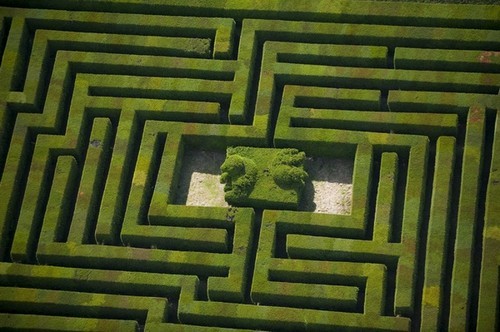Through Labyrinths
27 Jul 2010 - 09 Jan 2011
THROUGH LABYRINTHS
July 27, 2010 - January 9, 2011
Michael Ayrton, Jorge Luis Borges, Antonella Bussanich, Randoll Coate, Nick Coombe, Friedrich Dürrenmatt, Umberto Eco, Michele Emmer, Terry Fox, Martha Graham, Richard Long, Luis Longhi, Robert Morris, Lika Mutal, Ben Nicholson, Brian O’Doherty/ Patrick Ireland, Pierre Rosenstiehl, Ramón de Soto, Saul Steinberg, Josep Maria Subirachs, Oscar Tusquets, Jorge Wagensberg, Teri Wehn-Damisch.
This exhibition, with outline by Ramon Espelt, curated and designed by Oscar Tusquets, with Jorge Wagensberg as advisor, reviews the concept and representation of the labyrinth throughout history, making a clear distinction between single-path labyrinths and labyrinths with a choice of paths, or mazes.
The show comprises a series of very different spaces illustrated by works with a variety of different sources, formats, authors and periods, such as archaeological pieces, engravings, photographs, maps, screenings and models, plus pieces created specially for the exhibition.
1. Plaza
A shade structure will be created the Pati de les Dones courtyard, with the floor plan of a rectangular labyrinth. The shade structure will be suspended over the arches at the entrance and comprise a system of cables attached to which will be opaque squares forming the layout of the labyrinth. The shadow of this structure will form a labyrinth that visitors can walk around.
2. One-way labyrinths
Despite having just a single layout, this space will be intricate, in keeping with the aim of all labyrinths: the longest route with the smallest surface area (the divisions will be no more than a metre high).
An initial distinction will be made between conceptual labyrinths, drawn on stone or paper, which we can follow with our eyes or with a finger, and labyrinths which we can physically enter and walk around. This sector will include stone engravings, and Celtic, Christian and Central European labyrinths; the Cretan labyrinth represented on coins and Greek pottery, and in Roman mosaics; floor plans of ancient imagined cities drawn as labyrinths; historical labyrinths as a source of inspiration in contemporary works (such as Chartres cathedral), and labyrinths as memorials.
3. Crisis in the concept of the single-path labyrinth
This section will analyse issues such as the uselessness of Ariadne’s thread, Giovanni Fontana (15th c.) and the invention of the maze, the freedom to choose a route, the possibility of getting lost and the labyrinth as a cul-de-sac. It will also include a scientific approach: nature as a labyrinth, the labyrinth as an artistic metaphor for nature, and the labyrinth as a memory test.
4. Mazes
As opposed to the unicursal labyrinth, the layout of this space will offer a range of alternatives, possibilities of choice and culs-de-sac, though there will not be many divisions higher than eye level to prevent it being oppressive or confusing. From Egyptian, royal and literary tombs, in comic books and films, to mazes dating from between the 15th century up to the present day, and others like the library as a labyrinth (Borges, Eco, etc.).
July 27, 2010 - January 9, 2011
Michael Ayrton, Jorge Luis Borges, Antonella Bussanich, Randoll Coate, Nick Coombe, Friedrich Dürrenmatt, Umberto Eco, Michele Emmer, Terry Fox, Martha Graham, Richard Long, Luis Longhi, Robert Morris, Lika Mutal, Ben Nicholson, Brian O’Doherty/ Patrick Ireland, Pierre Rosenstiehl, Ramón de Soto, Saul Steinberg, Josep Maria Subirachs, Oscar Tusquets, Jorge Wagensberg, Teri Wehn-Damisch.
This exhibition, with outline by Ramon Espelt, curated and designed by Oscar Tusquets, with Jorge Wagensberg as advisor, reviews the concept and representation of the labyrinth throughout history, making a clear distinction between single-path labyrinths and labyrinths with a choice of paths, or mazes.
The show comprises a series of very different spaces illustrated by works with a variety of different sources, formats, authors and periods, such as archaeological pieces, engravings, photographs, maps, screenings and models, plus pieces created specially for the exhibition.
1. Plaza
A shade structure will be created the Pati de les Dones courtyard, with the floor plan of a rectangular labyrinth. The shade structure will be suspended over the arches at the entrance and comprise a system of cables attached to which will be opaque squares forming the layout of the labyrinth. The shadow of this structure will form a labyrinth that visitors can walk around.
2. One-way labyrinths
Despite having just a single layout, this space will be intricate, in keeping with the aim of all labyrinths: the longest route with the smallest surface area (the divisions will be no more than a metre high).
An initial distinction will be made between conceptual labyrinths, drawn on stone or paper, which we can follow with our eyes or with a finger, and labyrinths which we can physically enter and walk around. This sector will include stone engravings, and Celtic, Christian and Central European labyrinths; the Cretan labyrinth represented on coins and Greek pottery, and in Roman mosaics; floor plans of ancient imagined cities drawn as labyrinths; historical labyrinths as a source of inspiration in contemporary works (such as Chartres cathedral), and labyrinths as memorials.
3. Crisis in the concept of the single-path labyrinth
This section will analyse issues such as the uselessness of Ariadne’s thread, Giovanni Fontana (15th c.) and the invention of the maze, the freedom to choose a route, the possibility of getting lost and the labyrinth as a cul-de-sac. It will also include a scientific approach: nature as a labyrinth, the labyrinth as an artistic metaphor for nature, and the labyrinth as a memory test.
4. Mazes
As opposed to the unicursal labyrinth, the layout of this space will offer a range of alternatives, possibilities of choice and culs-de-sac, though there will not be many divisions higher than eye level to prevent it being oppressive or confusing. From Egyptian, royal and literary tombs, in comic books and films, to mazes dating from between the 15th century up to the present day, and others like the library as a labyrinth (Borges, Eco, etc.).

